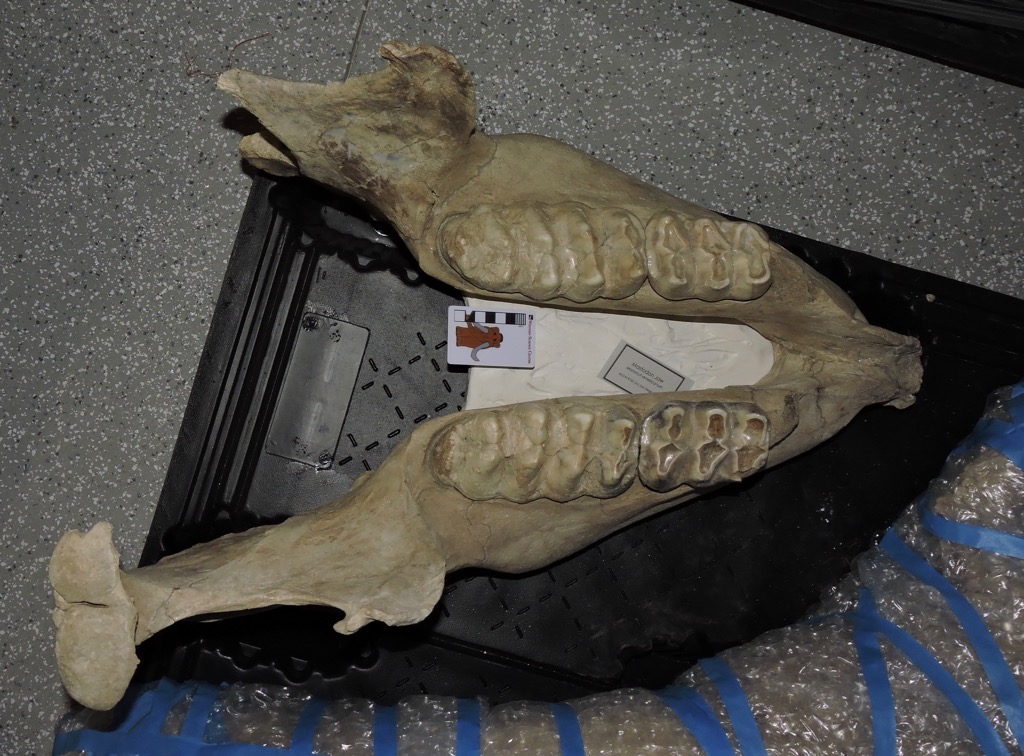 In a week Brett and I head out on our experiment.com-funded road trip to collect data on mastodon teeth. The major goal of this project is to collect enough data to better understand what's going on with mastodon tooth proportions, especially with respect to the apparently unusual California mastodons.The nicely preserved lower jaw shown above is a WSC specimen recovered from the San Diego Canal near Diamond Valley Lake, and which was included in our recently-closed "Stories from Bones" exhibit. Below is a dorsal view:
In a week Brett and I head out on our experiment.com-funded road trip to collect data on mastodon teeth. The major goal of this project is to collect enough data to better understand what's going on with mastodon tooth proportions, especially with respect to the apparently unusual California mastodons.The nicely preserved lower jaw shown above is a WSC specimen recovered from the San Diego Canal near Diamond Valley Lake, and which was included in our recently-closed "Stories from Bones" exhibit. Below is a dorsal view: This animal was a little smaller than Max, and based on tooth wear, a bit younger. While the first molars are lost, the third molars are just coming into wear, so this animal was likely in its early 20's.This specimen is of particular interest in our project, because it's an outlier. So far, this mastodon has the widest lower third molars of any California mastodon we've measured, and it's not really even close. The left molar on this specimen is almost 89 millimeters wide, while the next largest California specimen is just over 83 mm (the right molar is a bit narrower, but is still almost 85 mm). This is the only California specimen we've seen that has m3 proportions that approach typical Florida or Indiana specimens.The outlier status of this specimen is even more noticeable because, of the 14 California mastodons with m3 measurements currently in our database, 5 have m3 widths between 82.9 and 83.1 mm. That width seems to be a sharp line that California mastodons almost never cross, with the exception of this one specimen. (As an aside, gigantic Max's m3 is only 76.6 mm wide, one of the narrowest in our data set).As we examine additional California specimens, it's likely we'll eventually find other mastodons with teeth that are comparable to this specimen. But for now it stands out as the only California mastodon that has tooth proportions that approach those of eastern specimens.
This animal was a little smaller than Max, and based on tooth wear, a bit younger. While the first molars are lost, the third molars are just coming into wear, so this animal was likely in its early 20's.This specimen is of particular interest in our project, because it's an outlier. So far, this mastodon has the widest lower third molars of any California mastodon we've measured, and it's not really even close. The left molar on this specimen is almost 89 millimeters wide, while the next largest California specimen is just over 83 mm (the right molar is a bit narrower, but is still almost 85 mm). This is the only California specimen we've seen that has m3 proportions that approach typical Florida or Indiana specimens.The outlier status of this specimen is even more noticeable because, of the 14 California mastodons with m3 measurements currently in our database, 5 have m3 widths between 82.9 and 83.1 mm. That width seems to be a sharp line that California mastodons almost never cross, with the exception of this one specimen. (As an aside, gigantic Max's m3 is only 76.6 mm wide, one of the narrowest in our data set).As we examine additional California specimens, it's likely we'll eventually find other mastodons with teeth that are comparable to this specimen. But for now it stands out as the only California mastodon that has tooth proportions that approach those of eastern specimens.
